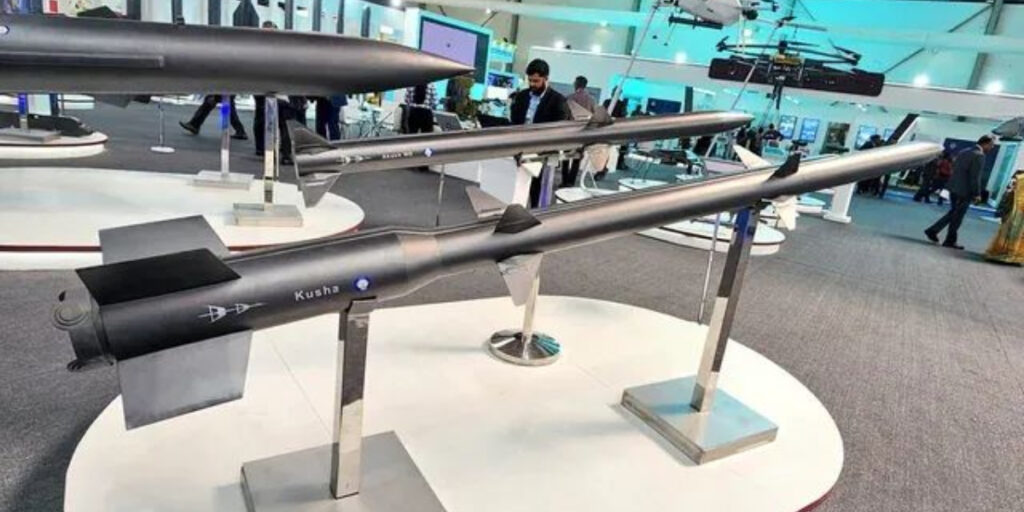Project Kusha: India’s Indigenous Long-Range SAM to Redefine Air Defence by 2028
Genesis of Project Kusha: A Strategic Necessity
Launched in 2019 under DRDO’s Ballistic Missile Defence (BMD) Phase-II, Project Kusha addresses gaps in India’s air defence against evolving threats: China’s J-20 stealth fighters (200+ deployed along LAC) and Pakistan’s potential Turkish TF Kaan acquisitions. The system’s three-tier missile suite—covering 150 km, 250 km, and 350 km—offers flexibility against fighters, cruise missiles, and hypersonics, unlike the S-400’s 400 km single-tier focus. Successful warhead tests at Pokhran in September 2025, intercepting simulated J-20 profiles at 200 km, signal readiness for production by Bharat Dynamics Limited (BDL) in Hyderabad.
Technical Prowess: A Homegrown Triad
Kusha’s architecture centers on a mobile, canister-launched missile system with AESA-based Long Range Tracking Radar (LRTR-II), co-developed with Bharat Electronics Limited (BEL). Its hit-to-kill warheads, guided by dual-mode seekers (RF/IR), achieve 98% accuracy against low-RCS targets. Integration with LODN’s optical sensors ensures jamming resistance, while AI-driven fire control, developed with IIT Bombay, enables autonomous target prioritization.
| Feature | Specification/Details |
|---|---|
| Range | 150 km, 250 km, 350 km (three missile variants) |
| Targets | Stealth fighters, hypersonic missiles, drones |
| Radar | LRTR-II AESA (400 km detection, 0.3 m² RCS) |
| Guidance | RF/IR dual-mode seekers, AI-driven fire control |
| Indigenous Content | 80% (BDL, BEL, private MSMEs) |
| Launch Platform | Mobile, canister-based (8 missiles/launcher) |
| Deployment | 5 regiments by 2028 (LAC, LoC, coastal) |
| Cost | ₹21,000 Cr for Phase 1 |
Kusha’s edge lies in its modularity: a single battery engages 24 targets simultaneously, surpassing Pakistan’s HQ-9 (200 km) and complementing S-400’s 36-target capacity. Its passive optical backup via LODN proved critical in simulations mimicking Sindoor’s EW-heavy environment.
Strategic Impact: LAC and LoC Deterrence
Post-Sindoor, where IAF’s S-400 and Rafales neutralized PAF assets without losses, Kusha strengthens India’s deterrence. Planned deployments in Ladakh, Arunachal, and Sir Creek by 2028 counter China’s PL-15-armed J-20s and Pakistan’s drone swarms. Defence Minister Rajnath Singh, in his October 2 Bhuj speech, called Kusha “India’s iron dome for the skies,” signaling robust response to LoC provocations. The system’s export potential to ASEAN/QUAD allies, backed by 15,000 jobs in Telangana and Karnataka, amplifies India’s defence industry.
Challenges and Future Horizons
While Kusha’s indigenous supply chain—leveraging MSMEs like Alpha Design—reduces foreign dependency, delays in high-thrust motor development and hypersonic intercept tests remain hurdles. DRDO aims for 2026 trials integrating Kusha with S-400 and Akashteer, eyeing full IACCS synergy by 2028. As IAF transitions from MiG-21s to Tejas Mk-1A, Kusha ensures aerial dominance, paving the way for BMD Phase-III against ICBMs.
Explore More:
Zorawar Light Tank for High-Altitude Warfare – Ground defence for border security.
India-UK £350M Missile Deal – Enhancing multi-layered defence.
Post-Op Sindoor: Pakistan’s Underground Airbases – Context for Kusha’s necessity.
DRDO’s LODN Stealth Detection – Optical synergy with Kusha.
S-400 Upgrades – Complementary air defence network.
Sources: IDRW, Indian Defence News, DRDO updates as of October 11, 2025.
DefenceNiti.com: Empowering India’s Defence Awareness | #ProjectKusha #AtmanirbharBharat #AirDefence



